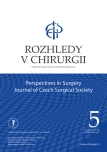-
Články
Top novinky
Reklama- Vzdělávání
- Časopisy
Top články
Nové číslo
- Témata
Top novinky
Reklama- Kongresy
- Videa
- Podcasty
Nové podcasty
Reklama- Kariéra
Doporučené pozice
Reklama- Praxe
Top novinky
ReklamaPenetrating abdominal trauma – selected case reports
Authors: P. Svoboda 1; R. Doležel 1; P. Kupka 2; J. Rudiš 1; Radek Pohnán 1
Authors place of work: Chirurgická klinika 2. lékařské Fakulty Univerzity Karlovy a Ústřední vojenské nemocnice Praha 1; Oddělení Emergency Ústřední vojenské nemocnice Praha 2
Published in the journal: Rozhl. Chir., 2021, roč. 100, č. 5, s. 246-251.
Category: Kazuistika
doi: https://doi.org/10.33699/PIS.2021.100.5.249–254Summary
We present 3 case-reports with penetrating abdominal injury from our practice in this article. An urgent laparotomy was performed in all cases because of haemodynamic instability or the mechanism of injury. Penetrative abdominal traumas are associated with a high risk of life-threatening intra-abdominal injuries, require urgent revision and are often accompanied by postoperative infections of the peritoneal cavity. In recent years, there has been a growing tendency towards mini-invasive approaches or even non-operative treatment. This trend is particularly evident in the United States of America, where doctors experience a higher number of penetrating injuries compared to the prevalent blunt force trauma in Europe. The authors describe the need to follow all recommended procedures in the pre-hospital and hospital phases of treatment of these patients and compare them with recent literature. Key words: penetrating abdominal trauma
Keywords:
penetrating abdominal trauma − ATLS – advanced trauma life support − damage control surgery
Zdroje
1. Věstník Ministerstva zdravotnictví ČR MZ 1/2021 : 16–17.
2. Casali M, Di Saverio S, Tugnoli G, et al. Penetrating abdominal trauma: 20 years experience in a Western European Trauma Center. Ann Ital Chir. 2008 Nov – Dec;79(6):399−407. PMID:19354033.
3. Costa G, Tierno SM, Tomassini F, et al. The epidemiology and clinical evaluation of abdominal trauma. An analysis of a multidisciplinary trauma registry. Ann Ital Chir. 2010 Mar–Apr;81(2):95−102. PMID:20726387.
4. Kuza CM, Hirji SA, Englum BR, et al. Pancreatic injuries in abdominal trauma in US adults: Analysis of the National Trauma Data Bank on management, outcomes, and predictors of mortality. Scand J Surg. 2020 Sep;109(3):193−204. doi:10.1177/1457496919851608. Epub 2019 May 29. PMID:31142209.
5. Bain K, Meytes V, Chang GC, et al. Laparoscopy in penetrating abdominal trauma is a safe and effective alternative to laparotomy. Surg Endosc. 2019 May;33(5):1618−1625. doi:10.1007/ s00464-018-6436-1. Epub 2018 Sep 12. PMID:30209608.
6. Malkomes P, Störmann P, El Youzouri H, et al. Characteristics and management of penetrating abdominal injuries in a German level I trauma center. Eur J Trauma Emerg Surg. 2019 Apr;45(2):315−321. doi:10.1007/s00068-018-0911-1. Epub 2018 Jan 22. PMID:29356844.
7. Waes OV, Lieshout EV, Silfhout DV, et al. Selective non-operative management for penetrating abdominal injury in a Dutch trauma centre. Ann R Coll Surg Engl. 2020 May;102(5):375−382. doi:10.1308/ rcsann.2020.0042.
8. Laing GL, Skinner DL, Bruce JL, et al. A multi-faceted quality improvement programme results in improved outcomes for the selective non-operative management of penetrating abdominal trauma in a developing world trauma centre. Injury 2014 Jan;45(1):327−332. doi:10.1016/j.injury.2013.08.021.
9. Goin G, Massalou D, Bege T, et al. Feasibility of selective non-operative management for penetrating abdominal trauma in France. J Visc Surg. 2017 Jun;154(3):167−174. doi:10.1016/j.jviscsurg. 2016.08.006. Epub 2016 Nov 14. PMID:27856172.
10. Galvagno SM Jr, Nahmias JT, Young DA. Advanced Trauma Life Support® update 2019: Management and applications for adults and special populations. Anesthesiol Clin. 2019;37(1):13−32. doi:10.1016/j. anclin.2018.09.009.
11. Teuben M, Löhr N, Jensen KO, et al. Improved pre-hospital care efficiency due to the implementation of pre-hospital trauma life support (PHTLS®) algorithms. European Journal of Trauma and Emergency Surgery 2020;46 : 1321–1325. doi:10.1007/s00068-019-01141-1.
12. Biffl WL, & Moore EE. Management guidelines for penetrating abdominal trauma. Current opinion in critical care 2010;16(6):609−617.
13. Biffl WL, & Leppaniemi A. Management guidelines for penetrating abdominal trauma. World J Surg. 2015;39(6):1373−1380.
14. Wang Y, Alnumay A, Paradis T, et al. Management of open abdomen after trauma laparotomy: A comparative analysis of dynamic fascial traction and negative pressure wound therapy systems. World J Surg. 2019 Dec;43(12):3044−3050. doi:10.1007/s00268-019-05166-w. PMID: 31506714.
15. Hall C, Regner J, Abernathy S, et al. Surgical site infection after primary closure of high-risk surgical wounds in emergency general surgery laparotomy and closed negative-pressure wound therapy. J Am Coll Surg. 2019 Apr;228(4):393−397. doi:10.1016/j.jamcollsurg.2018.12.006. Epub 2018 Dec 23. PMID:30586643.
Štítky
Chirurgie všeobecná Ortopedie Urgentní medicína
Článek vyšel v časopiseRozhledy v chirurgii
Nejčtenější tento týden
2021 Číslo 5- Metamizol jako analgetikum první volby: kdy, pro koho, jak a proč?
- Stillova choroba: vzácné a závažné systémové onemocnění
- S MUDr. Petrou Vysočanovou o hypertenzi u diabetiků: Jak léčit skutečně účinně a bez zbytečných rizik?
- Jak na správnou léčbu omrzlin?
-
Všechny články tohoto čísla
- Vojenská chirurgie ve vojenské nemocnici
- Miniinvazivní pankreatické resekce ve světle důkazů − state of the art
- Update podtlakové terapie pro rok 2021
- Roboticky asistovaná léčba rektálního karcinomu – výsledky nerandomizované studie
- 10 let laparoskopické tubulizace žaludku v Ústřední vojenské nemocnici Praha
- Resekce hlavy pankreatu v terénu stenózy truncus coeliacus: kazuistika a přehled literatury
- Posttraumatická interkostální plicní herniace – kazuistika
- Penetrující poranění břicha – vybrané kazuistiky
- The impact of the Covid-19 pandemic on hernia surgery in the University Hospital in the Czech Republic
- Rozhledy v chirurgii
- Archiv čísel
- Aktuální číslo
- Informace o časopisu
Nejčtenější v tomto čísle- Update podtlakové terapie pro rok 2021
- Posttraumatická interkostální plicní herniace – kazuistika
- Penetrující poranění břicha – vybrané kazuistiky
- 10 let laparoskopické tubulizace žaludku v Ústřední vojenské nemocnici Praha
Kurzy
Zvyšte si kvalifikaci online z pohodlí domova
Autoři: prof. MUDr. Vladimír Palička, CSc., Dr.h.c., doc. MUDr. Václav Vyskočil, Ph.D., MUDr. Petr Kasalický, CSc., MUDr. Jan Rosa, Ing. Pavel Havlík, Ing. Jan Adam, Hana Hejnová, DiS., Jana Křenková
Autoři: MUDr. Irena Krčmová, CSc.
Autoři: MDDr. Eleonóra Ivančová, PhD., MHA
Autoři: prof. MUDr. Eva Kubala Havrdová, DrSc.
Všechny kurzyPřihlášení#ADS_BOTTOM_SCRIPTS#Zapomenuté hesloZadejte e-mailovou adresu, se kterou jste vytvářel(a) účet, budou Vám na ni zaslány informace k nastavení nového hesla.
- Vzdělávání



